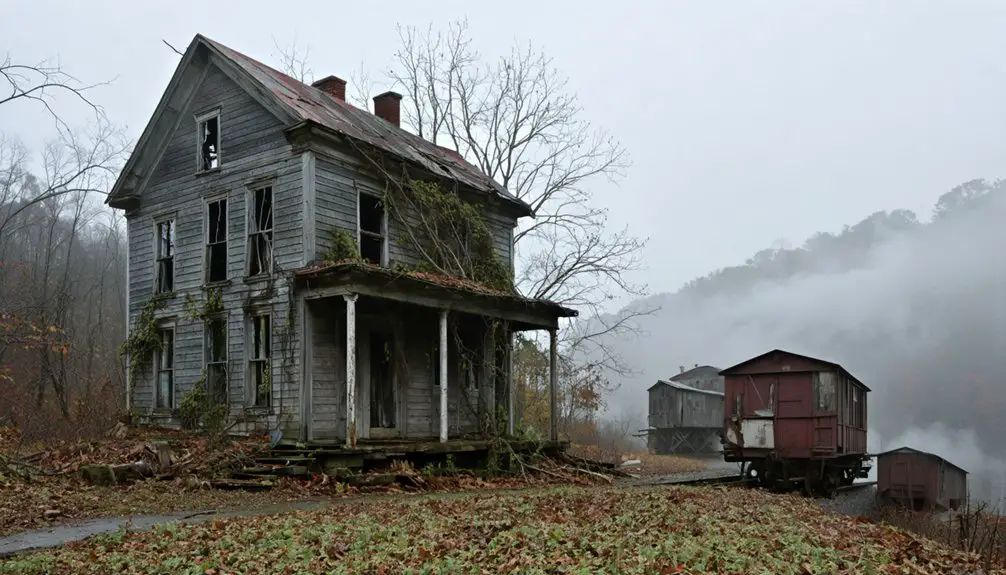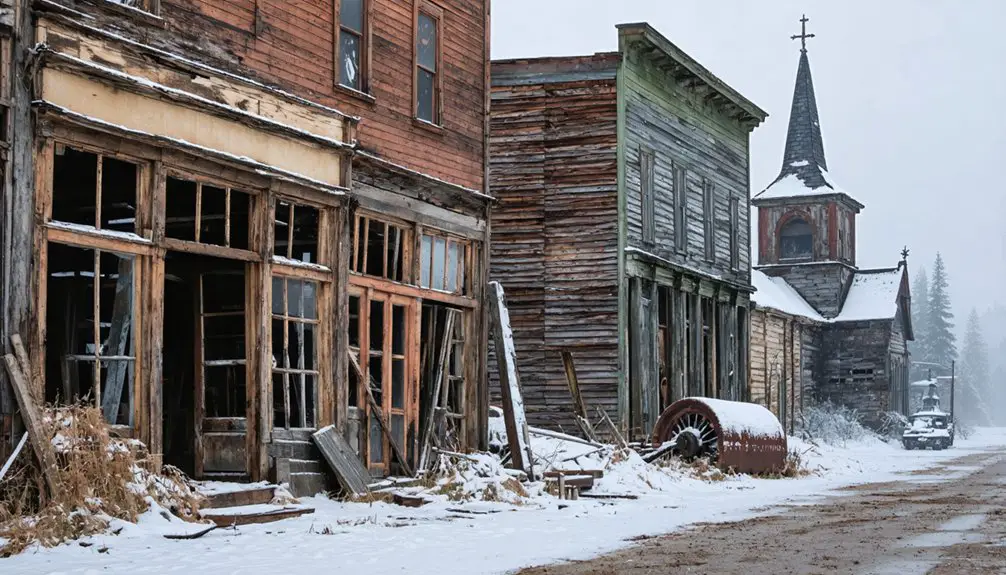You’ll find Sewell’s haunting remains in West Virginia’s New River Gorge, where it began as Bowyer’s Ferry in 1798 before becoming an industrial powerhouse. The town pioneered coke production in 1874 with 50 beehive ovens, eventually expanding to 200. Its strategic location along the C&O Railroad made it a crucial transportation hub until 1956, when operations ceased. The abandoned town‘s remarkably preserved coke ovens and ruins tell a compelling story of Appalachian innovation and decline.
Key Takeaways
- Sewell began as a thriving coal mining and coke production hub in 1798, operating until its complete abandonment in 1973.
- The town’s economy centered around 200 beehive coke ovens, which operated continuously from 1874 to 1956.
- Remnants of the ghost town include preserved coke ovens, company store ruins, and railway structures accessible via hiking trails.
- The site is now part of New River Gorge National Park, preserving its historical significance in Appalachian industrial development.
- Economic decline following the closure of coke production in 1956 led to residents gradually leaving in search of work elsewhere.
From Ferry Crossing to Industrial Hub
While many ghost towns emerged from sudden booms and busts, Sewell’s metamorphosis began as Bowyer’s Ferry in 1798, when Peter Bowyer established an essential river crossing on the New River.
This strategic ferry crossing became a crucial link between Charleston and Lewisburg, drawing early settlers to the area and sparking initial settlement development around the transportation hub.
You’ll find Sewell’s evolution accelerated dramatically with the arrival of the Chesapeake and Ohio railroad in the late 1800s. The town became a vital coke processing point, reducing coal from surrounding hills for steel production in the north.
The former ferry site transformed into Sewell Station, and the town quickly emerged as an industrial powerhouse.
The addition of Mann’s Creek Railroad in 1886 further expanded Sewell’s reach, connecting its growing network of coal mines and coke ovens to broader markets, marking its shift from riverside crossing to thriving industrial center. At its height, the town operated nearly 200 coke ovens that fueled its economic success.
The Rise of Coke Production
After the arrival of the Chesapeake and Ohio Railroad in 1873, Sewell’s industrial transformation took a pivotal turn with Longdale Coal Company‘s construction of 50 beehive coke ovens in 1874.
The coke ovens continued burning coal until 1956 in West Virginia, marking the end of an era for this historic operation.
As the first coke production facility in the New River Gorge, Sewell quickly established itself as a dominant force in the coke market, eventually expanding to nearly 200 ovens.
The operation continued under Babcock Coal & Coke Co. before being acquired by Royalty Smokeless Coal Company.
You’ll find these remarkable achievements defined Sewell’s industrial might:
- Strategic positioning along the C&O rail line enabled efficient distribution to hungry blast furnaces
- A skilled labor workforce managed the complex process of converting coal to high-quality coke
- Sustained operations for almost a century, powered by coal from local mines and later from Clifftop via the Manns Creek Railroad
The beehive ovens became the backbone of regional steel production, transforming raw coal into essential fuel for iron smelting.
Life in a Mountain Mining Town
During Sewell’s peak years, life in this mountain mining town revolved entirely around the demanding rhythms of coal extraction and coke production.
You’d find yourself living in a wooden company house, sharing crowded streets with fellow miners and their families, many of whom brought their cultural heritage from distant lands. Immigrant laborers like Vito Crater endured grueling shifts in the mines to provide for their families.
Despite harsh conditions and limited amenities, community resilience shone through in church gatherings and social events at the local halls.
Your daily existence would’ve centered on the company store, where you’d exchange scrip for essentials, while your children might attend the basic company school or help with small jobs.
The ever-present coal dust and coke oven smoke would fill your lungs, yet the tight-knit community found ways to persevere through the challenges of this industrial mountain life.
Railroad’s Influence on Growth
The arrival of the Chesapeake and Ohio Railroad in 1873 marked the beginning of Sewell’s transformation from a remote mountain outpost into a bustling industrial hub. Much like the efficient coal transport demonstrated by the Virginian Railway years later, these rail connections revolutionized the region’s industrial capabilities.
The railroad’s significance extended far beyond mere transportation, catalyzing a dramatic economic transformation that would define the town for generations. The Sewell Valley Railroad played a crucial role when established by the Raine brothers to support their ambitious lumber operations.
You’ll appreciate how the railroad shaped Sewell’s destiny through these key developments:
- Construction of the Sewell Valley Railroad in 1907, adding 20 miles of track and connecting the town’s lumber mill to major rail lines
- Establishment of up to 200 coke ovens, positioning Sewell as a regional processing center
- Creation of essential transport links that sustained the town’s economy even when local mines closed
The railroad didn’t just move coal and lumber – it built a thriving community that connected Appalachian resources to national markets.
Engineering Marvel of the Beehive Ovens
You’ll find the beehive ovens at Sewell were masterfully engineered dome structures where coal burned for up to 72 hours in a controlled, low-oxygen environment to produce high-quality coke.
The innovative larry car system, running on tracks atop the ovens, efficiently delivered coal and removed finished coke through a sophisticated network of conveyors adapted to the gorge’s challenging terrain.
These industrial marvels expanded from an initial 50 ovens in 1874 to become the region’s largest coking operation with 202 ovens by World War I, showcasing how engineering ingenuity transformed raw coal into essential coke for the iron industry. To avoid confusion with other places named Sewell, historians often refer to this site as Sewell Ghost Town when discussing its industrial heritage.
Coke Production Process
Standing as marvels of 19th-century industrial engineering, Sewell’s beehive coke ovens transformed raw coal into high-quality coke through an ingenious process of controlled heating.
You’ll find nearly 200 brick-domed ovens that operated continuously from 1874 to 1956, making them the last active beehive ovens in southern West Virginia.
- Coal from local mines was loaded into the dome-shaped ovens and heated for 48-72 hours without direct air contact.
- The ovens’ design promoted carbonization over combustion, ensuring superior coke quality despite environmental impact from smoke emissions.
- A sophisticated chain conveyor system and larry car tracks efficiently moved the finished coke to waiting railcars.
Through this pyrolysis process, the ovens removed moisture and impurities while increasing carbon concentration, creating the essential fuel needed for iron smelting operations.
Industrial Design Innovations
Built with remarkable engineering precision, Sewell’s beehive coke ovens showcased innovative industrial design through their circular, vaulted chambers and sophisticated material handling systems.
You’ll find 193 ovens constructed with firebrick walls and flat tile bottoms, featuring arched doors for air control and coke retrieval. The industrial design incorporated “larry” cars running on elevated tracks, enabling efficient coal charging from above.
This engineering marvel represented cutting-edge technology for its time, though you’d notice its environmental drawbacks. The innovation impact extended beyond Sewell, influencing regional coke production methods throughout Appalachia.
While lacking modern efficiency features like waste heat recovery, these ovens demonstrated remarkable durability, operating continuously from 1874 to 1956 and establishing Sewell as a pioneering force in America’s industrial development. The Longdale Iron Co. established this groundbreaking coke production facility, setting new standards for the region.
Daily Operations at Peak Production
During Sewell’s peak production years, the town operated as a bustling industrial hub where nearly 200 beehive coke ovens transformed raw coal into valuable metallurgical coke.
You’d have witnessed a complex orchestration of labor dynamics, with workers performing round-the-clock tasks to keep production flowing.
- Coke oven maintenance crews monitored temperatures and adjusted air flow continuously, ensuring ideal burning conditions.
- Railroad workers coordinated coal deliveries from both Sewell and Clifftop mines via the Mann’s Creek Railroad.
- Teams of specialists managed the charging of ovens, cooling of finished coke, and loading onto larry cars for transport.
The daily rhythm included miners extracting coal, railroad crews shuttling materials, and skilled laborers tending the beehive ovens. Panoramic group portraits from 1957 documented the day force workers at nearby Mine #5 in Nettie.
Like a well-orchestrated symphony, miners, railroad crews, and skilled laborers performed their daily roles in Sewell’s industrial dance.
This intricate dance of industrial activity kept Sewell’s economic engine running until its eventual decline in 1956.
Natural Resources That Built Sewell
You’ll discover that coal was the foundation of Sewell’s industrial rise, with rich seams first tapped by the Longdale Iron Company in 1873 providing essential fuel for coke production.
The town’s strategic position along the New River created natural flat areas perfect for industrial development, while the arrival of the C&O Railroad that same year enabled efficient transport of coal and coke products.
This combination of abundant coal reserves and ideal geography transformed Sewell into the region’s largest coke production center, featuring nearly 200 beehive ovens that operated until 1956.
Coal Powers Industrial Growth
The industrial rise of Sewell began in 1873 when the Longdale Iron Company established the first coal mining operation near Sewell Depot, coinciding with the railroad’s completion.
You’ll find that this pioneering venture transformed the region, as Sewell became home to the Gorge’s first coke ovens and largest coking facility.
The town’s rapid growth in coal extraction and industrial workforce was driven by three key developments:
- Construction of 50 beehive-style coke ovens in 1874
- Expansion to nearly 200 ovens during peak operations
- Strategic location along the C&O railroad line for efficient transport
As Sewell’s operations expanded, it wasn’t just about mining anymore – the town became a crucial hub for converting coal into coke, fueling iron blast furnaces across the region until 1956.
New River’s Strategic Location
Located along one of North America’s oldest waterways, Sewell’s position within the New River Gorge proved instrumental to its industrial success beyond coal mining.
You’ll find the river’s northward flow through deep canyons created natural corridors that shaped the region’s development. The river ecology supported diverse resources across 70,000 acres, while its geological significance as one of the continent’s most ancient waterways provided stable pathways for transportation and industrial growth.
The New River’s strategic value extended beyond industrial uses. The rugged terrain and abundant water resources attracted settlers who recognized the area’s potential for timber harvesting, agriculture, and spring water development.
Today, you can still witness how this natural corridor’s unique features continue supporting activities from whitewater rafting to rock climbing.
The Path to Abandonment
While Sewell prospered as an essential coal and coke production hub through the late 1800s and early 1900s, its journey toward abandonment began with the gradual decline of its industrial backbone.
The town’s economic reliance on coal and coke production proved fatal when the industry began to falter, triggering a population migration that would eventually leave the town empty.
The final chapter of Sewell’s story unfolded through:
- The closure of 200 coke ovens in 1956, ending nearly a century of production
- A steady exodus of residents seeking work elsewhere, until only one railroad worker remained
- Complete abandonment by 1973, leaving only foundations and a water spring as evidence of the once-thriving community
Today, you’ll find Sewell’s remnants accessible only by hiking trails, slowly returning to nature.
Preserved Remnants Today
Standing as silent witnesses to Sewell’s industrial past, numerous structural remnants dot the landscape within Babcock State Park and New River Gorge National Park.
You’ll find stone foundations of former buildings, an intact brick chimney, and vault structures from the old mining office and company store. The historical significance of the site is most evident in the preserved coke ovens that stretch for a third of a mile, representing some of southern West Virginia’s oldest industrial structures.
The visitor experience requires careful navigation through rugged terrain, where you’ll discover discarded mining machinery, railroad artifacts, and industrial equipment among the dense forest canopy.
While nature gradually reclaims the town, you can still trace Sewell’s layout through its foundations, spring house, and scattered remnants of its coal-loading operations.
Legacy in Appalachian History
When you explore Sewell today, you’ll find the remnants of a once-thriving industrial hub that embodied Appalachia’s economic transformation from the 1790s through the mid-20th century.
You can trace the town’s evolution from Bowyer’s Ferry to a bustling coal and coke production center that housed over 300 residents at its peak, complete with company stores, banking facilities, and an extensive rail network.
The town’s abandonment in 1973 marks a poignant chapter in the broader narrative of Appalachian mining communities, where the decline of extractive industries led to the dissolution of entire towns, leaving behind physical reminders of both prosperity and loss.
Industrial Prosperity’s Rise Falls
As coal mines across the New River Gorge gradually depleted their reserves, Sewell’s once-bustling industrial empire began its descent into obsolescence.
You can trace the town’s economic decline from its peak of industrial innovation in the late 19th century to its final days in 1973, when the last resident departed.
Here’s what sealed Sewell’s fate:
- The exhaustion of local coal mines, undermining the town’s primary economic foundation
- The closure of the revolutionary 200-beehive coke oven complex in 1956, ending an era of metallurgical production
- The termination of coal shipments on the Manns Creek Railroad in the early 1950s, severing essential transportation arteries
What you’re seeing in Sewell’s story is a microcosm of Appalachian industrial transformation – from thriving coal town to silent representation of America’s shifting economic landscape.
Community Memory Lives On
Though Sewell’s industries have long since fallen silent, the town’s legacy endures through its remarkably preserved physical remains and rich oral histories.
You’ll find more than a third-mile of coke ovens, company store ruins, and railway structures that tell the story of this pioneering coal town. The spring that once quenched miners’ thirst still flows pure and cold.
Community narratives paint vivid pictures of daily life, preserved through stories passed down by former residents and their descendants.
Memory preservation efforts within the New River Gorge National Park guarantee Sewell’s significance in Appalachian culture won’t fade.
As the region’s first commercial mining hub, Sewell exemplifies the resilience of mountain communities and serves as a powerful reminder of coal’s influence on Appalachian identity.
Frequently Asked Questions
How Dangerous Were Working Conditions in Sewell’s Mines and Coke Operations?
You’d face lethal working conditions with mine safety practically nonexistent – three deaths per 1,000 workers annually. Labor disputes erupted as you’d risk cave-ins, explosions, fires, and toxic coke emissions.
What Happened to the Families Who Lived in Sewell After Closure?
By 1973, you’d find zero permanent residents left. When the coke ovens closed in ’56, families scattered for survival, relocating to nearby towns, breaking up tight-knit community bonds as they sought new work.
Are There Any Ghost Stories or Legends Associated With Sewell?
You’ll find Sewell legends centered on phantom industrial sounds, ghostly miners, and mysterious figures near the old ruins. Local hauntings include stories of ethereal train whistles and spirits lingering by the spring.
Can Visitors Legally Explore and Photograph the Ghost Town Today?
You can legally explore and photograph the site since it’s within Babcock State Park, but you’ll need to hike 6-7 miles on approved trails and follow park regulations regarding photography and preservation.
What Was the Average Wage for Workers in Sewell’s Industrial Heyday?
If you were a steel mill worker in 1979, you’d have earned around $16 per hour, equivalent to the state’s median industrial wage of $16.47, with additional union benefits like healthcare and pensions.
References
- https://www.onlyinyourstate.com/experiences/west-virginia/sewell-in-wv
- http://freepages.rootsweb.com/~gtusa/history/usa/wv/sewell.htm
- https://officialbridgeday.com/bridge-blog/history-of-sewell-coal-mine-community
- https://www.coalzoom.com/article.cfm?articleid=32350
- https://en.wikipedia.org/wiki/Sewell
- https://coalcampusa.com/sowv/river/sewell/sewell.htm
- https://coalcampusa.com/sowv/river/newriver.htm
- https://archives.lib.wvu.edu/repositories/2/archival_objects/136049
- https://www.youtube.com/watch?v=_RczGBKsQPA
- https://www.nps.gov/parkhistory/online_books/steamtown/shs2l.htm



